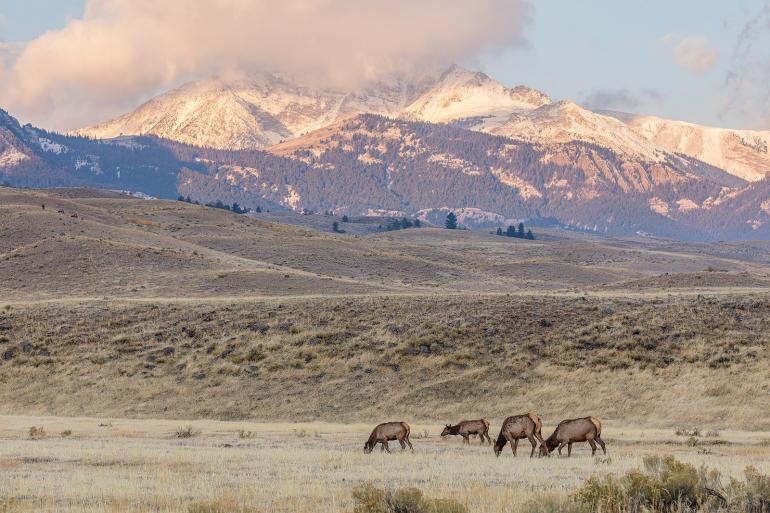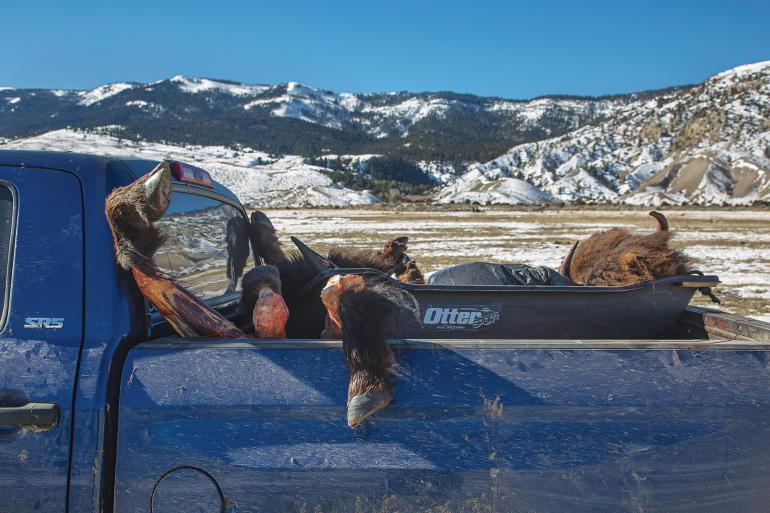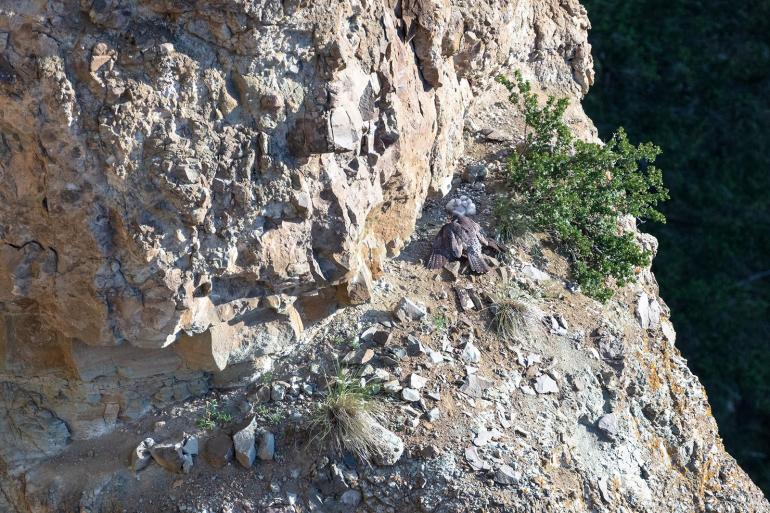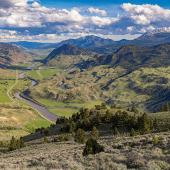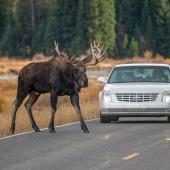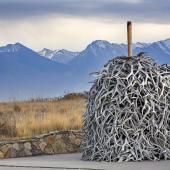Greater Yellowstone Park
A plea to improve upon America’s best idea.
Anyone who has visited Yellowstone National Park has surely been awed by the splendor of its thermal features, abundant wildlife, and scenic beauty. But surrounding the Park are millions of acres of other public lands equally worthy of reverence, primarily managed by the U.S. Forest Service (FS) and several other federal agencies, including the Bureau of Land Management (BLM) and U.S. Fish and Wildlife Service (FWS).
Collectively, these public lands make up the Greater Yellowstone Ecosystem (GYE)—a 23-million-acre chunk of the American West where wolves and grizzlies still roam, and ecological and evolutionary processes still dominate the landscape. But beyond the Park boundaries, regulations are relatively lax, and the ecosystem is under threat from encroaching development. To better protect this Park-adjacent wildlife habitat, I propose that the American people expand Yellowstone’s boundaries to include the administrative jurisdiction of the National Park Service (NPS) over surrounding public lands.
Why Protect Large Areas?
One of the basic tenets of conservation biology is that you must go big: large, protected areas are the most effective means of ensuring the long-term preservation of evolutionary opportunities, adaptation to climate change, and species survival.
Since its creation in 1872, Yellowstone has been a model of conservation that has spread across the globe. The idea of preserving wild nature through national parks, Wilderness Areas, and other reserves has expanded partly because of all available conservation strategies. Simply put, it is the best way to protect wild nature.
While millions of people visit Yellowstone annually, the National Park Service puts a premium on wildlife protection.
Nevertheless, the GYE needs greater protection to ensure its resilience as a functioning ecosystem in a world of climate warming and ever-increasing human pressures. What greater gift to humanity and all life forms could the United States provide than maximizing the preservation of the largest uninterrupted temperate ecosystem in the world?
Role of the Park Service
The NPS has a fundamental mission to preserve the lands under its administration as “unimpaired.” Our national parks are among the best-managed public lands in America. That is one reason why Yellowstone still possesses all the species that existed at the time of the first European exploration in the early 1800s.
Though not immune to political pressures that sometimes result in less-than-desirable outcomes for nature, overall, the NPS has a biocentric management worldview. The agency aims to preserve natural processes like predation, maintain sufficient species populations to preclude inbreeding, and manage natural processes like wildfire that have historically shaped the ecosystem.
While millions of people visit Yellowstone annually, the NPS puts a premium on wildlife protection. For example, the NPS has designated Bear Management Areas where humans are excluded or confined to existing trails to minimize conflicts with bears. The NPS also restricts access around known eagle and peregrine nest sites, wolf dens, and trout spawning streams to lessen the disturbance to these animals. It also has initiated a policy on native-fish restoration.
The Greater Yellowstone Ecosystem’s public lands are not the nation’s wood box, feedlot, or oil tap.
Resource extraction, including mining, logging, oil and gas development, hunting, livestock grazing, and industrial-level tourism like ski resorts, are all prohibited. These activities are currently permitted on other public lands outside the Park, including those managed by the FS and BLM. They also occur on private lands, alongside the construction of new roads and subdivisions.
The GYE’s public lands are not the nation’s wood box, feedlot, or oil tap. All these resource-extraction activities are marginal economic activities. There are better places for the nation to obtain wood, graze livestock, or drill for oil with fewer environmental consequences and financial subsidies.
The highest value of public lands in the GYE is the “three Ws:” wildlands, wildlife, and watersheds. We should emphasize and expand these values in managing GYE public lands.
And therein is the problem: although the 2.2 million acres encompassing the Park are well protected, most of the remaining land within the 23-million-acre GYE is available and open to these ecologically-compromising activities.
In 2002, my colleagues and I completed a biological survey of the GYE. We identified locations with high biodiversity values, and potential threats to these values. Nearly all the threats were a consequence of the above resource-extraction activities. All areas with high-threat ratings were outside Yellowstone on other federal or private lands. In the two decades since we completed our survey, nearly all the threats we identified have amplified and increased.
If we wish to ensure the continued function of the GYE as a global model of conservation, transferring the administration of the ecosystem’s federal lands to the NPS is our best option for preserving the ecosystem’s ecological integrity.
A Greater Preserve
We are seeing the consequences of continued status quo—a loss in open space, severed wildlife-migration corridors, more species threatened with extinction, loss in carbon storage, and degradation in wildness.
One of the values of our national parks is that they teach us self-restraint and personal responsibility. They also promote consideration of non-human species and the existence value of all life.
An expanded Park would protect migration corridors, enhance water quality, conserve wildlife habitat, and preserve scenic beauty. It would also have significant economic benefits for surrounding communities: national parks attract “footloose” businesses and provide countless economic opportunities.
In addition, there would be other, less obvious economic consequences by way of the costs we would otherwise incur to protect or restore damaged lands. Protecting wildlife habitat would mean spending less money on restoring endangered species or simply protecting existing species populations. Because methane emissions from oil and gas fields are a significant source of air pollution, banning these activities on public lands would improve the public’s air. Eliminating water pollution from mining, livestock grazing, and logging would mean less cost for community water sources. Protecting lands from mining or logging would help ensure scenic beauty is preserved (imagine how a clearcut near your home would devalue its salability).
In terms of the feasibility of my proposal, a public process would be needed to determine what activities on current non-NPS-administered lands could continue (such as hunting, for example). This is currently the case in Denali National Park & Preserve, where sport hunting is allowed on only the preserve portion, which is twice the size of the park. Other national parks, such as Grand Teton, also allow for limited hunting in the parks themselves. This could perhaps be the case in Greater Yellowstone National Park. But prohibiting resource extraction, as with all NPS lands, is the primary change I would anticipate.
Creating a Greater Yellowstone National Park would solidify the United States’s position as a global conservation leader and preserve our common heritage. It’s something well worth considering.
George Wuerthner is an ecologist with over 40 years of field experience and nearly as many books to his name. He is the executive director of Public Lands Media.


